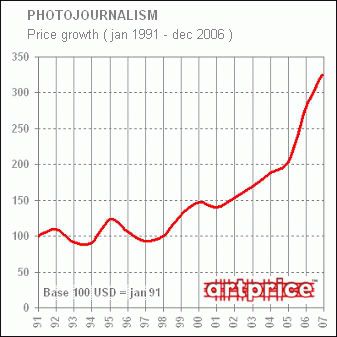Here's the piece:
Today, the boundaries between photo-reportage and art photography are more blurred than ever as collectors increasingly seek out the work of photojournalists. This is visible not only in galleries, but at auction. Artprice.com summarizes some examples of the shifting trend and explain which photos sell and why.

Collective memory and photography
The photojournalism market is booming. Turnover at auction has risen by more than 500 percent in 10 years and the trend is strong in the USA, France and the UK. For many years, photojournalism was considered a secondary form of art, much like scientific or ethnographic photography, because photojournalism's original goal is to disseminate information. Since the 1950s, however, photojournalism has built a reputation on its aesthetics and techniques as well as on its testimonial values partly thanks to World Press Photo with its annual contest celebrating the year's best journalistic photographs, and due to a number of exhibitions in museums underlining the news photo's dual role as documentary testimony and aesthetic artifact.
The great names of photojournalism - Cecil Beaton, Henri Cartier-Bresson, Robert Capa, Raymond Depardon, Robert Doisneau, Walker Evans, Dorothea Lange and Marc Riboud - all documented their times through sensitive images of undeniable cultural significance. Many of these are now finding their way into cultural institutions, prized for a combination of the iconic value of the shots and the photographers' commitment, as well as aesthetic considerations (definition of the image, framing, etc.).
In auction houses, the price of these historic pictures is mostly determined by the year of the print. The date the photo was printed must be as close as possible to the date the photo was taken.
No comments:
Post a Comment